Amlodipine Besylate and Benazepril Hydrochloride
HIGHLIGHTS OF PRESCRIBING INFORMATIONThese highlights do not include all the information needed to use amlodipine besylate and benazepril hydrochloride safely and effectively. See full prescribing information for amlodipine besylate and benazepril hydrochloride capsules. Amlodipine Besylate and Benazepril Hydrochloride CapsulesInitial U.S. Approval: 1995RECENT MAJOR CHANGES(2)(4)(5.5)BOXED WARNING WARNING: FETAL TOXICITY See full prescribing information for complete boxed warning When pregnancy is detected, discontinue amlodipine besylate and benazepril hydrochloride as soon as possible (5.5). Drugs that act directly on the renin-angiotensin system can cause injury and death to the developing fetus. (5.5) INDICATIONS AND USAGE(1)DOSAGE AND ADMINISTRATION Dose once-daily. May be used as add-on therapy for patients not adequately controlled with either a dihydropyridine calcium channel blocker or an ACE inhibitor. (2.2) Patients who experience edema with amlodipine may be switched to amlodipine besylate and benazepril hydrochloride capsules containing a lower dose of amlodipine. (2.2) Start amlodipine besylate and benazepril hydrochloride capsules at 2.5 mg/10 mg in patients ≥ 75 years old or in patients with hepatic impairment. (2) DOSAGE FORMS AND STRENGTHS(3)CONTRAINDICATIONS Do not co-administer aliskiren with ARBs or ACEIs, including amlodipine besylate and benazepril hydrochloride capsules in patients with diabetes. (4) Amlodipine besylate and benazepril hydrochloride capsules are contraindicated in patients with a history of angioedema, with or without previous ACE inhibitor treatment, or patients who are hypersensitive to benazepril, to any other ACE inhibitor, or to amlodipine. (4) WARNINGS AND PRECAUTIONS Watch for anaphylactoid reactions, including angioedema (head, neck or intestinal). (5.1) Warn patients with severe obstructive coronary artery disease about the risk of myocardial infarction or increased angina. (5.2) Assess for hypotension and hyperkalemia. (5.3 and 5.7) Avoid fetal or neonatal exposure. (5.5) Titrate slowly in patients with impaired hepatic (5.5) or severely impaired renal (5.6) function. Side Effects(6) To report SUSPECTED ADVERSE REACTIONS, contact Aurobindo Pharma USA, Inc. at 1-866-850-2876 or FDA at 1-800-FDA-1088 or www.fda.gov/medwatch.DRUG INTERACTIONS Potassium supplements/Potassium-sparing diuretics: Risk of hyperkalemia. (7.1) Lithium: Increased serum lithium levels; toxicity symptoms. (7.1) Injectable gold: Facial flushing, nausea, vomiting, or hypotension may occur. (7.1) NSAID: Risk of renal dysfunction, loss of antihypertensive effect. (7.1) If simvastatin is co-administered with amlodipine, do not exceed doses greater than 20 mg daily of simvastatin. (7.1) Dual inhibition of the rennin-angiotensin system: Increased risk of renal impairment, hypotension, and hyperkalemia. (7.1) USE IN SPECIFIC POPULATIONS Nursing Mothers: It is not known whether amlodipine is excreted in human milk. Nursing or drug should be discontinued. (8.3)
FULL PRESCRIBING INFORMATION: CONTENTS*
- WARNING: FETAL TOXICITY
- 1 AMLODIPINE BESYLATE AND BENAZEPRIL HYDROCHLORIDE INDICATIONS AND USAGE
- 2 AMLODIPINE BESYLATE AND BENAZEPRIL HYDROCHLORIDE DOSAGE AND ADMINISTRATION
- 3 DOSAGE FORMS AND STRENGTHS
- 4 AMLODIPINE BESYLATE AND BENAZEPRIL HYDROCHLORIDE CONTRAINDICATIONS
- 5 WARNINGS AND PRECAUTIONS
- 5.1 Anaphylactoid and Possibly Related Reactions
- 5.2 Increased Angina and/or Myocardial Infarction
- 5.3 Patients with Aortic and Mitral Valve Stenosis, Obstructive Hypertrophic Cardiomyopathy
- 5.4 Hypotension
- 5.5 Fetal Toxicity
- 5.6 Hepatitis and Hepatic Failure
- 5.7 Impaired Renal Function
- 5.8 Hyperkalemia
- 5.9 Cough
- 5.10 Surgery/Anesthesia
- 6 AMLODIPINE BESYLATE AND BENAZEPRIL HYDROCHLORIDE ADVERSE REACTIONS
- 7 DRUG INTERACTIONS
- 8 USE IN SPECIFIC POPULATIONS
- 10 OVERDOSAGE
- 11 AMLODIPINE BESYLATE AND BENAZEPRIL HYDROCHLORIDE DESCRIPTION
- 12 CLINICAL PHARMACOLOGY
- 13 NONCLINICAL TOXICOLOGY
- 14 CLINICAL STUDIES
- 16 HOW SUPPLIED/STORAGE AND HANDLING
- 17 PATIENT COUNSELING INFORMATION
- FDA-Approved Patient Labeling
- PACKAGE LABEL-PRINCIPAL DISPLAY PANEL - 2.5 mg/10 mg (100 Capsule Bottle)
- PACKAGE LABEL-PRINCIPAL DISPLAY PANEL - 5 mg/10 mg (100 Capsule Bottle)
- PACKAGE LABEL-PRINCIPAL DISPLAY PANEL - 5 mg/20 mg (100 Capsule Bottle)
- PACKAGE LABEL-PRINCIPAL DISPLAY PANEL - 5 mg/40 mg (100 Capsule Bottle)
- PACKAGE LABEL-PRINCIPAL DISPLAY PANEL - 10 mg/20 mg (100 Capsule Bottle)
- PACKAGE LABEL-PRINCIPAL DISPLAY PANEL - 10 mg/40 mg (100 Capsule Bottle)
FULL PRESCRIBING INFORMATION
WARNING: FETAL TOXICITY
When pregnancy is detected, discontinue amlodipine besylate and benazepril hydrochloride as soon as possible [see Warnings and Precautions (5.5)]. Drugs that act directly on the renin-angiotensin system can cause injury and death to the developing fetus [see Warnings and Precautions (5.5) ].
1 INDICATIONS AND USAGE
1.1 Hypertension
2 DOSAGE AND ADMINISTRATION
2.1 General Considerations
The recommended initial dose of amlodipine besylate and benazepril hydrochloride capsules is one capsule of amlodipine 2.5 mg and benazepril 10 mg orally once daily.
It is usually appropriate to begin therapy with amlodipine besylate and benazepril hydrochloride capsules only after a patient has either (a) failed to achieve the desired antihypertensive effect with amlodipine or benazepril monotherapy, or (b) demonstrated inability to achieve adequate antihypertensive effect with amlodipine therapy without developing edema.
The antihypertensive effect of amlodipine besylate and benazepril hydrochloride capsules is largely attained within 2 weeks. If blood pressure remains uncontrolled, the dose may be titrated up to amlodipine 10 mg and benazepril 40 mg once daily. The dosing should be individualized and adjusted according to the patient’s clinical response .
2.2 Dosage Adjustment in Renal Impairment
Renal Impairment: Amlodipine besylate and benazepril hydrochloride capsules are not recommended in patients with creatinine clearance ≤ 30 mL/min. No dose adjustment of amlodipine besylate and benazepril hydrochloride capsules is required in patients creatinine clearance > 30 mL/min (serum creatinine roughly ≤3 mg/dL or 265 μmol/L) [see Warnings and Precautions (5.7), Use in Specific Populations (8.7) and Clinical Pharmacology (12.3)].
2.3 Replacement Therapy
3 DOSAGE FORMS AND STRENGTHS
4 CONTRAINDICATIONS
- Do not co-administer aliskiren with angiotensin receptor blockers, ACE inhibitors, including amlodipine besylate and benazepril hydrochloride capsules in patients with diabetes.
- Amlodipine besylate and benazepril hydrochloride capsules are contraindicated in patients with a history of angioedema, with or without previous ACE inhibitor treatment, or patients who are hypersensitive to benazepril, to any other ACE inhibitor, to amlodipine, or to any of the excipients of amlodipine besylate and benazepril hydrochloride capsules.
5 WARNINGS AND PRECAUTIONS
5.1 Anaphylactoid and Possibly Related Reactions
Head and Neck Angioedema: When involvement of the tongue, glottis, or larynx appears likely to cause airway obstruction, appropriate therapy, e.g., administer subcutaneous epinephrine injection 1:1000 (0.3 to 0.5 mL), promptly [see Adverse Reactions (6)]
Intestinal Angioedema:
Anaphylactoid Reactions During Desensitization:
Anaphylactoid Reactions During Membrane Exposure:
5.2 Increased Angina and/or Myocardial Infarction
Worsening angina and acute myocardial infarction can develop after starting or increasing the dose of amlodipine, particularly in patients with severe obstructive coronary artery disease.
5.3 Patients with Aortic and Mitral Valve Stenosis, Obstructive Hypertrophic Cardiomyopathy
As with all other vasodilators, special caution is required when using amlodipine in patients suffering from aortic or mitral stenosis, or obstructive hypertrophic cardiomyopathy.
5.4 Hypotension
Amlodipine besylate and benazepril hydrochloride can cause symptomatic hypotension. Symptomatic hypotension is most likely to occur in patients who have been volume or salt depleted as a result of diuretic therapy, dietary salt restriction, dialysis, diarrhea, or vomiting. Volume and/or salt depletion should be corrected before starting therapy with benazepril. If hypotension occurs, the patient should be placed in the supine position and if necessary given physiological saline i.v. Treatment with benazepril can be continued once blood pressure and volume have returned to normal.
In patients with congestive heart failure, with or without associated renal insufficiency, ACE inhibitor therapy may cause excessive hypotension, which may be associated with oliguria, azotemia, and (rarely) with acute renal failure and death. In such patients, start amlodipine besylate and benazepril hydrochloride therapy under close medical supervision; follow closely for the first 2 weeks of treatment and whenever the dose of the benazepril component is increased or a diuretic is added or its dose increased.
Symptomatic hypotension is also possible in patients with severe aortic stenosis.
5.5 Fetal Toxicity
Pregnancy Category D
Use of drugs that act on the renin-angiotensin system during the second and third trimesters of pregnancy reduces fetal renal function and increases fetal and neonatal morbidity and death. Resulting oligohydramnios can be associated with fetal lung hypoplasia and skeletal deformations. Potential neonatal adverse effects include skull hypoplasia, anuria, hypotension, renal failure, and death. When pregnancy is detected, discontinue amlodipine besylate and benazepril hydrochloride as soon as possible [see Use in Specific Populations (8.1)] .
5.6 Hepatitis and Hepatic Failure
There have been rare reports of predominantly cholestatic hepatitis and isolated cases of acute liver failure, some of them fatal, in patients on ACE inhibitors. The mechanism is not understood. Patients receiving ACE inhibitors who develop jaundice or marked elevation of hepatic enzymes should discontinue the ACE inhibitor and be kept under medical surveillance.
5.7 Impaired Renal Function
Monitor renal function periodically in patients treated with amlodipine besylate and benazepril hydrochloride. Changes in renal function, including acute renal failure, can be caused by drugs that affect the renin-angiotensin system. Patients whose renal function may depend in part on the activity of the renin-angiotensin system (e.g., patients with renal artery stenosis, severe heart failure, post-myocardial infarction or volume depletion) or who are on NSAIDs or angiotensin receptor blockers may be at particular risk of developing acute renal failure on amlodipine besylate and benazepril hydrochloride. Consider withholding or discontinuing therapy in patients who develop a clinically significant decrease in renal function on amlodipine besylate and benazepril hydrochloride.
5.8 Hyperkalemia
Monitor serum potassium periodically in patients receiving amlodipine besylate and benazepril hydrochloride. Drugs that affect the renin-angiotensin system can cause hyperkalemia. Risk factors for the development of hyperkalemia include renal insufficiency, diabetes mellitus, and the concomitant use of potassium-sparing diuretics, potassium supplements, and/or potassium-containing salt substitutes. In U.S. placebo-controlled trials of amlodipine besylate and benazepril hydrochloride, hyperkalemia (serum potassium at least 0.5 mEq/L greater than the upper limit of normal) not present at baseline occurred in approximately 1.5% of hypertensive patients receiving amlodipine besylate and benazepril hydrochloride. Increases in serum potassium were generally reversible.
5.9 Cough
Presumably due to the inhibition of the degradation of endogenous bradykinin, persistent nonproductive cough has been reported with all ACE inhibitors, generally resolving after discontinuation of therapy. Consider ACE inhibitor-induced cough in the differential diagnosis of cough.
5.10 Surgery/Anesthesia
6 ADVERSE REACTIONS
6.1 Clinical Trials Experience
| Benazepril and Amlodipine N=760 |
Benazepril N=554 |
Amlodipine N=475 |
Placebo N=408 |
|
|---|---|---|---|---|
| *Edema refers to all edema, such as dependent edema, angioedema, facial edema. |
||||
| Cough |
3.3 |
1.8 |
0.4 |
0.2 |
| Headache |
2.2 |
3.8 |
2.9 |
5.6 |
| Dizziness |
1.3 |
1.6 |
2.3 |
1.5 |
| Edema* |
2.1 |
0.9 |
5.1 |
2.2 |
Body as a Whole:
CNS:
Dermatologic:
Digestive:
Hematologic:
Metabolic and Nutritional:
Musculoskeletal:
Respiratory:
Urogenital:
6.2 Post-marketing Experience
Because these reactions are reported voluntarily from a population of uncertain size, it is not always possible to reliably estimate their frequency or establish a causal relationship to drug exposure.
In postmarketing experience with benazepril, there have been rare reports of Stevens-Johnson syndrome, pancreatitis, hemolytic anemia, pemphigus, thrombocytopenia, paresthesia, dysgeusia, orthostatic symptoms and hypotension, angina pectoris and arrhythmia, pruritus, photosensitivity reaction, arthralgia, arthritis, myalgia, BUN increase, serum creatinine increased, renal impairment, impaired vision, agranulocytosis, neutropenia.
Rare reports in association with use of amlodipine: gingival hyperplasia, tachycardia, jaundice, and hepatic enzyme elevations (mostly consistent with cholestasis severe enough to require hospitalization), leucocytopenia, allergic reaction, hyperglycemia, dysgeusia, hypoestheia, paresthesia, syncope, peripheral neuropathy, hypertonia, visual impairment, diplopia, hypotension, vasculitis, rhinitis, gastritis, hyperhidrosis, pruritis, skin discoloration, urticaria, erythema multiforme, muscle spasms, arthralgia, micturition disorder, nocturia, erectile dysfunction, malaise, weight decrease or gain.
Other potentially important adverse experiences attributed to other ACE inhibitors and calcium channel blockers include: eosinophilic pneumonitis (ACE inhibitors) and gynecomastia (CCBs). Other infrequently reported events included chest pain, ventricular extrasystole, gout, neuritis, tinnitus, alopecia, upper respiratory tract infection, palpitations and somnolence.
7 DRUG INTERACTIONS
7.1 Drug/Drug Interactions
Amlodipine
Simvastatin: Co-administration of simvastatin with amlodipine increases the systemic exposure of simvastatin. Limit the dose of simvastatin in patients on amlodipine to 20 mg daily.
CYP3A4 Inhibitors
: Co-administration with CYP3A inhibitors (moderate and strong) results in increased systemic exposure to amlodipine and may require dose reduction. Monitor for symptoms of hypotension and edema when amlodipine is co-administered with CYP3A4 inhibitors to determine the need for dose adjustment.
CYP3A4 Inducers
: No information is available on the quantitative effects of CYP3A4 inducers on amlodipine. Blood pressure should be monitored when amlodipine is co-administered with CYP3A4 inducers.
Benazepril
Potassium Supplements and Potassium-Sparing Diuretics:
Benazepril can attenuate potassium loss caused by thiazide diuretics. Potassium-sparing diuretics (spironolactone, amiloride, triamterene, and others) or potassium supplements can increase the risk of hyperkalemia. If concomitant use of such agents is indicated, the patient’s serum potassium should be monitored frequently.
Lithium:
Increased serum lithium levels and symptoms of lithium toxicity have been reported in patients receiving ACE inhibitors during therapy with lithium. When coadministering amlodipine besylate and benazepril hydrochloride and lithium, frequent monitoring of serum lithium levels is recommended.
Gold:
Nitritoid reactions (symptoms include facial flushing, nausea, vomiting and hypotension) have been reported rarely in patients on therapy with injectable gold (sodium aurothiomalate) and concomitant ACE inhibitor therapy.
Non-Steroidal Anti-Inflammatory Agents including Selective Cyclooxygenase-2 Inhibitors (COX-2 Inhibitors):
In patients who are elderly, volume-depleted (including those on diuretic therapy), or with compromised renal function, co-administration of NSAIDs, including selective COX-2 inhibitors, with ACE inhibitors, including benazepril, may result in deterioration of renal function, including possible acute renal failure. These effects are usually reversible. Monitor renal function periodically in patients receiving benazepril and NSAID therapy.
The antihypertensive effect of ACE inhibitors, including benazepril, may be attenuated by NSAIDs.
Antidiabetic agents:
In rare cases, diabetic patients receiving an ACE inhibitor (including benazepril) concomitantly with insulin or oral antidiabetics may develop hypoglycemia. Such patients should therefore be advised about the possibility of hypoglycemic reactions, and should be monitored accordingly.
Dual Blockade of the Renin-Angiotensin System (RAS):
Dual blockade of the RAS with angiotensin receptor blockers, ACE inhibitors, or aliskiren is associated with increased risks of hypotension, hyperkalemia, and changes in renal function (including acute renal failure) compared to monotherapy. Closely monitor blood pressure, renal function and electrolytes in patients on amlodipine besylate and benazepril hydrochloride and other agents that block the RAS.
Do not co-administer aliskiren with amlodipine besylate and benazepril hydrochloride in patients with diabetes. Avoid use of aliskiren with amlodipine besylate and benazepril hydrochloride in patients with renal impairment (GFR <60 mL/min).
8 USE IN SPECIFIC POPULATIONS
8.1 Pregnancy
in utero[see Use in Specific Populations (8.4) ].
8.2 Labor and Delivery
The effect of amlodipine besylate and benazepril hydrochloride on labor and delivery has not been studied.
8.3 Nursing Mothers
8.4 Pediatric Use
Neonates with a history of in utero exposure to amlodipine besylate and benazepril hydrochloride:
8.5 Geriatric Use
In geriatrics, exposure to amlodipine is increased, thus consider lower initial doses of amlodipine besylate and benazepril hydrochloride [see Clinical Pharmacology (12.3)].
Of the total number of patients who received amlodipine besylate and benazepril hydrochloride in U.S. clinical studies of amlodipine besylate and benazepril hydrochloride, over 19% were 65 or older while about 2% were 75 or older. Overall differences in effectiveness or safety were not observed between these patients and younger patients. Clinical experience has not identified differences in responses between the elderly and younger patients, but greater sensitivity of some older individuals cannot be ruled out.
8.6 Hepatic Impairment
Exposure to amlodipine is increased in patients with hepatic insufficiency, thus consider using lower doses of amlodipine besylate and benazepril hydrochloride [see Clinical Pharmacology (12.3)].
8.7 Renal Impairment
In patients with severe renal impairment systemic exposure to benazepril is increased. The recommended dose of benazepril in this subgroup is 5 mg which is not an available strength with amlodipine besylate and benazepril hydrochloride. Amlodipine besylate and benazepril hydrochloride is not recommended in patients with severe renal impairment. No dose adjustment of amlodipine besylate and benazepril hydrochloride is needed in patients with mild or moderate impairment of renal function [see Dosage and Administration (2.2), Warnings and Precautions (5.7) and Clinical Pharmacology (12.3)].
10 OVERDOSAGE
Only a few cases of human overdose with amlodipine have been reported. One patient was asymptomatic after a 250 mg ingestion; another, who combined 70 mg of amlodipine with an unknown large quantity of a benzodiazepine, developed refractory shock and died.
Human overdoses with any combination of amlodipine and benazepril have not been reported. In scattered reports of human overdoses with benazepril and other ACE inhibitors, there are no reports of death.
Treatment:
Patients should be admitted to hospital and, generally, should be managed in an intensive care setting, with continuous monitoring of cardiac function, blood gases, and blood biochemistry. Emergency supportive measures such as artificial ventilation or cardiac pacing should be instituted if appropriate.
In the event of a potentially life-threatening oral overdose, use induction of vomiting or gastric lavage and/or activated charcoal to remove the drug from the gastrointestinal tract (only if presented within 1 hour after ingestion of amlodipine besylate and benazepril hydrochloride).
Other clinical manifestations of overdose should be managed symptomatically based on modern methods of intensive care.
To obtain up-to-date information about the treatment of overdose, a good resource is your certified Regional Poison Control Center. Telephone numbers of certified poison control centers are listed in the Physicians’ Desk Reference (PDR). In managing overdose, consider the possibilities of multiple-drug overdoses, drug-drug interactions, and unusual drug kinetics in your patient.
The most likely effect of overdose with amlodipine besylate and benazepril hydrochloride is vasodilation, with consequent hypotension and tachycardia. Simple repletion of central fluid volume (Trendelenburg positioning, infusion of crystalloids) may be sufficient therapy, but pressor agents (norepinephrine or high-dose dopamine) may be required. With abrupt return of peripheral vascular tone, overdoses of other dihydropyridine calcium channel blockers have sometimes progressed to pulmonary edema, and patients must be monitored for this complication.
Analyses of bodily fluids for concentrations of amlodipine, benazepril, or their metabolites are not widely available. Such analyses are, in any event, not known to be of value in therapy or prognosis.
No data are available to suggest physiologic maneuvers (e.g., maneuvers to change the pH of the urine) that might accelerate elimination of amlodipine, benazepril, or their metabolites. Benazeprilat is only slightly dialyzable; attempted clearance of amlodipine by hemodialysis or hemo-perfusion has not been reported, but amlodipine’s high protein binding makes it unlikely that these interventions will be of value.
Angiotensin II could presumably serve as a specific antagonist-antidote to benazepril, but angiotensin II is essentially unavailable outside of scattered research laboratories.
11 DESCRIPTION
H
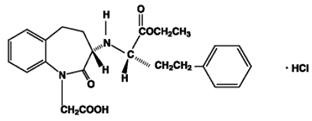
242825
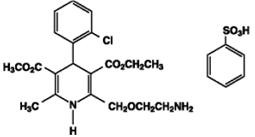
202525663
12 CLINICAL PHARMACOLOGY
12.1 Mechanism of Action
Benazepril
[see Warnings and Precautions (5)]
Amlodipine
in vitro
12.2 Pharmacodynamics
Benazepril
[see Warnings and Precautions (5)]
Amlodipine
12.3 Pharmacokinetics
The rate and extent of absorption of benazepril and amlodipine from amlodipine besylate and benazepril hydrochloride are same as when administered as individual tablets. Absorption from the individual tablets is not influenced by the presence of food in the gastrointestinal tract; food effects on absorption from amlodipine besylate and benazepril hydrochloride have not been studied.
Absorption:
Following oral administration of amlodipine besylate and benazepril hydrochloride, peak plasma concentrations of amlodipine are reached in 6 to 12 hours. Absolute bioavailability has been calculated as between 64% and 90%. Following oral administration of amlodipine besylate and benazepril hydrochloride, the peak plasma concentrations of benazepril are reached in 0.5 to 2 hours. The cleavage of the ester group (primarily in the liver) converts benazepril to its active metabolite, benazeprilat, which reaches peak plasma concentrations in 1.5 to 4 hours. The extent of absorption of benazepril is at least 37%. Amlodipine and benazepril exhibit dose proportional pharmacokinetics between the therapeutic dose range of 2.5 and 10 mg and 10 and 20 mg, respectively.
Distribution:
The apparent volume of distribution of amlodipine is about 21 L/kg. In vitro studies indicate that approximately 93% of circulating amlodipine is bound to plasma proteins in hypertensive patients. The apparent volume of distribution of benazeprilat is about 0.7 L/kg. Approximately 93% of circulating amlodipine is bound to plasma proteins, and the bound fraction of benazeprilat is slightly higher. On the basis of in vitro studies, benazeprilat’s degree of protein binding should be unaffected by age, by hepatic dysfunction, or—over the therapeutic concentration range—by concentration.
Metabolism:
Amlodipine is extensively (approximately 90%) metabolized in the liver to inactive metabolites. Benazepril is extensively metabolized to form benazeprilat as the main metabolite, which occur by enzymatic hydrolysis, mainly in the liver. Two minor metabolites are the acyl glucuronide conjugates of benazepril and benazeprilat.
Elimination:
Amlodipine elimination from plasma is biphasic with a terminal elimination half-life of approximately 30 to 50 hours. Steady-state plasma levels are reached after once-daily dosing for 7 to 8 days. 10% of unchanged drug and 60% of amlodipine metabolites are excreted in urine. Effective elimination half-life of amlodipine is 2 days. Benazepril is eliminated mainly by metabolic clearance. Benazeprilat is eliminated via the kidneys and the bile; renal excretion is the main route in patients with normal renal function. In the urine, benazepril accounts for less than 1% and benazeprilat for about 20% of an oral dose. Elimination of benazeprilat is biphasic with an initial half-life of about 3 hours and a terminal half-life of about 22 hours. Benazeprilat’s effective elimination half-life is 10 to11 h, while that of amlodipine is about 2 days, so steady-state levels of the two components are achieved after about a week of once-daily dosing.
Special populations
Geriatric patients
: No specific clinical studies were performed to understand the impact of age on the pharmacokinetics of amlodipine and benazepril as fixed dose combination. As individual component amlodipine is extensively metabolized in the liver. In the elderly, clearance of amlodipine is decreased with resulting increases in peak plasma levels, elimination half-life and area-under-the-plasma-concentration curve [see Use in Specific Populations (8.5)].
Hepatic impairment:
Patients with hepatic insufficiency have decreased clearance of amlodipine with a resulting increase in AUC of approximately 40 to 60%. Pharmacokinetics of benazepril is not significantly influenced by hepatic impairment [see Use in Specific Populations (8.6)].
Renal impairment
: The disposition of benazepril and benazeprilat in patients with mild-to-moderate renal insufficiency (creatinine clearance > 30 mL/min) is similar to that in patients with normal renal function. In patients with creatinine clearance ≤ 30 mL/min, peak benazeprilat levels and the effective half-life increase, resulting in higher systemic exposures. Pharmacokinetics of amlodipine is not significantly influenced by renal impairment [see Dosage and Administration (2.2), Use in Specific Populations (8.7) and Warnings and Precautions (5.7)].
Drug interactions
Amlodipine
In vitro data in human plasma indicate that amlodipine has no effect on the protein binding of digoxin, phenytoin, warfarin, and indomethacin.
Cimetidine
: Co-administration of amlodipine with cimetidine did not alter the pharmacokinetics of amlodipine.
Grapefruit juice
: Co-administration of 240 mL of grapefruit juice with a single oral dose of amlodipine 10 mg in 20 healthy volunteers had no significant effect on the pharmacokinetics of amlodipine.
Maalox® (antacid)
: Co-administration of the antacid Maalox with a single dose of amlodipine had no significant effect on the pharmacokinetics of amlodipine.
Sildenafil: A single 100 mg dose of sildenafil in subjects with essential hypertension had no effect on the pharmacokinetic parameters of amlodipine. When amlodipine and sildenafil were used in combination, each agent independently exerted its own blood pressure lowering effect.
Atorvastatin
: Co-administration of multiple 10 mg doses of amlodipine with 80 mg of atorvastatin resulted in no significant change in the steady-state pharmacokinetic parameters of atorvastatin.
Digoxin
: Co-administration of amlodipine with digoxin did not change serum digoxin levels or digoxin renal clearance in normal volunteers.
Ethanol (alcohol)
: Single and multiple 10 mg doses of amlodipine had no significant effect on the pharmacokinetics of ethanol.
Warfarin
: Co-administration of amlodipine with warfarin did not change the warfarin prothrombin response time.
Simvastatin
: Co-administration of multiple doses of 10 mg of amlodipine with 80 mg simvastatin resulted in a 77% increase in exposure to simvastatin compared to simvastatin alone.
CYP3A inhibitors
: Co-administration of a 180 mg daily dose of diltiazem with 5 mg amlodipine in elderly hypertensive patients resulted in a 60% increase in amlodipine systemic exposure. Erythromycin co-administration in healthy volunteers did not significantly change amlodipine systemic exposure. However, strong inhibitors of CYP3A4 (e.g., ketoconazole, itraconazole, ritonavir) may increase the plasma concentrations of amlodipine to a greater extent.
Benazepril
The pharmacokinetic properties of benazepril are not affected by hydrochlorothiazide, furosemide, chlorthalidone, digoxin, propranolol, atenolol, nifedipine, amlodipine, naproxen, acetylsalicylic acid, or cimetidine. Likewise the administration of benazepril does not substantially affect the pharmacokinetics of these medications.
13 NONCLINICAL TOXICOLOGY
13.1 Carcinogenesis, Mutagenesis, Impairment of Fertility
Carcinogenicity and mutagenicity studies have not been conducted with this combination. However, these studies have been conducted with amlodipine and benazepril alone (see below). No adverse effects on fertility occurred when the benazepril:amlodipine combination was given orally to rats of either sex at doses up to 15:7.5 mg (benazepril:amlodipine)/kg/day, prior to mating and throughout gestation.
Benazepril:
No evidence of carcinogenicity was found when benazepril was administered to rats and mice for up to two years at doses of up to 150 mg/kg/day. When compared on the basis of body surface area, this dose is 18 and 9 times (rats and mice, respectively) the maximum recommended human dose (calculations assume a patient weight of 60 kg). No mutagenic activity was detected in the Ames test in bacteria, in an in vitro test for forward mutations in cultured mammalian cells, or in a nucleus anomaly test. At doses of 50 to 500 mg/kg/day (6 to 60 times the maximum recommended human dose on a body surface area basis), benazepril had no adverse effect on the reproductive performance of male and female rats.
Amlodipine:
Rats and mice treated with amlodipine maleate in the diet for up to two years, at concentrations calculated to provide daily dosage levels of 0.5, 1.25, and 2.5 mg amlodipine/kg/day, showed no evidence of a carcinogenic effect of the drug. For the mouse, the highest dose was, on a body surface area basis, similar to the maximum recommended human dose [MRHD] of 10 mg amlodipine/day. For the rat, the highest dose was, on a body surface area basis, about two and a half times the MRHD. (Calculations based on a 60 kg patient.) Mutagenicity studies conducted with amlodipine maleate revealed no drug-related effects at either the gene or chromosome level. There was no effect on the fertility of rats treated orally with amlodipine maleate (males for 64 days and females for 14 days prior to mating) at doses of up to 10 mg amlodipine/kg/day (about 10 times the MRHD of 10 mg/day on a body surface area basis).
13.3 Reproductive Toxicity
When rats received benazepril:amlodipine at doses ranging from 5:2.5 to 50:25 mg/kg/day, dystocia was observed at an increasing dose-related incidence at all doses tested. On a body surface area basis, the 2.5 mg/kg/day dose of amlodipine is 3.6 times the amlodipine dose delivered when the maximum recommended dose of amlodipine besylate and benazepril hydrochloride is given to a 50 kg woman. Similarly, the 5 mg/kg/day dose of benazepril is approximately twice the benazepril dose delivered when the maximum recommended dose of amlodipine besylate and benazepril hydrochloride is given to a 50 kg woman. No teratogenic effects were seen when benazepril and amlodipine were administered in combination to pregnant rats or rabbits. Rats received doses of up to 50:25 mg (benazepril:amlodipine) /kg/day (24 times the maximum recommended human dose on a body surface area basis, assuming a 50 kg woman). Rabbits received doses of up to 1.5:0.75 mg/kg/day (equivalent to the maximum recommended dose of amlodipine besylate and benazepril hydrochloride given to a 50 kg woman).
Benazepril:
No teratogenic effects of benazepril were seen in studies of pregnant rats, mice, and rabbits. On a body surface area basis, the maximum doses used in these studies were 60 times (in rats), 9 times (in mice), and about equivalent to (in rabbits) the maximum recommended human dose (assuming a 50 kg woman).
Amlodipine:
No evidence of teratogenicity or other embryo/fetal toxicity was found when pregnant rats and rabbits were treated orally with amlodipine maleate at doses of up to 10 mg amlodipine/kg/day (respectively, about 10 and 20 times the maximum recommended human dose [MRHD] of 10 mg amlodipine on a body surface area basis) during their respective periods of major organogenesis. (Calculations based on a patient weight of 60 kg.) However, litter size was significantly decreased (by about 50%) and the number of intrauterine deaths was significantly increased (about 5-fold) for rats receiving amlodipine maleate at a dose equivalent to 10 mg amlodipine/kg/day for 14 days before mating and throughout mating and gestation. Amlodipine maleate has been shown to prolong both the gestation period and the duration of labor in rats at this dose. There are no adequate and well-controlled studies in pregnant women. Amlodipine should be used during pregnancy only if the potential benefit justifies the potential risk to the fetus.
14 CLINICAL STUDIES
16 HOW SUPPLIED/STORAGE AND HANDLING
Amlodipine Besylate and Benazepril Hydrochloride Capsules, 2.5 mg/10 mg
Amlodipine Besylate and Benazepril Hydrochloride Capsules, 5 mg/10 mg
Amlodipine Besylate and Benazepril Hydrochloride Capsules, 5 mg/20 mg
Amlodipine Besylate and Benazepril Hydrochloride Capsules, 5 mg/40 mg
Amlodipine Besylate and Benazepril Hydrochloride Capsules, 10 mg/20 mg
Amlodipine Besylate and Benazepril Hydrochloride Capsules, 10 mg/40 mg
Store at
17 PATIENT COUNSELING INFORMATION
Information for Patients
®
Aurobindo Pharma USA, Inc.
Aurobindo Pharma Limited
FDA-Approved Patient Labeling
Patient Information
Amlodipine Besylate and Benazepril Hydrochloride Capsules
What is the most important information I should know about amlodipine besylate and benazepril hydrochloride capsules
- Amlodipine besylate and benazepril hydrochloride capsules can cause harm or death to an unborn baby.
- Talk to your doctor about other ways to lower your blood pressure if you plan to become pregnant.
- If you get pregnant while taking amlodipine besylate and benazepril hydrochloride capsules, tell your doctor right away.
What are amlodipine besylate and benazepril hydrochloride capsules?
®®
High Blood Pressure (hypertension).
Who should not take amlodipine besylate and benazepril hydrochloride capsules?
Don’t take amlodipine besylate and benazepril hydrochloride capsules if you are allergic to any of the ingredients.
What should I tell my doctor before taking amlodipine besylate and benazepril hydrochloride capsules?
- you are pregnant or plan to become pregnant. See “What is the most important information I should know about amlodipine besylate and benazepril hydrochloride capsules?”
- you are breastfeeding. Amlodipine besylate and benazepril hydrochloride may pass into your milk. Don’t breastfeed while you are taking amlodipine besylate and benazepril hydrochloride capsules.
- you have a heart condition
- you have liver problems
- you have kidney problems
- you are about to have an operation (including dental surgery) or emergency treatment
- you are suffering from several episodes of vomiting or diarrhea
- you are treated for hyperkalemia (too much potassium in the blood)
- you are taking already a diuretic (a medicine to increase the amount of urine you produce)
Keep a list of your medicines with you, including vitamins and natural or herbal remedies, to show your doctor or pharmacist. Some of your other medicines and amlodipine besylate and benazepril hydrochloride capsules could affect each other, causing serious side effects. Tell your doctor about all your medicines, especially:
- Simvastatin, (a medicine used to control elevated cholesterol)
- medicines for high blood pressure or heart failure
- water pills, extra potassium or a salt substitute
- Lithium (Eskalith®, Lithobid®)
- potassium-containing medicines, potassium supplements or salt substitutes containing potassium;
- ciclosporin, an immunosuppressant medicine used in transplanted patients to reduce the risk of organ rejection;
- indomethacin and other non-steroidal anti-inflammatory agents, medicines used to relieve pain and inflammation;
- insulin or oral antidiabetics, medicines that help a person with diabetes to control their level of glucose (sugar) in the blood;
- gold for the treatment of rheumatoid arthritis;
- probenecid, a medicine used to treat gout and hyperuricemia;
- medicines used to prevent and treat fungal skin infections (e.g., ketoconazole, itraconazole)
- medicines used to treat AIDS or HIV infections (e.g., ritonavir, indinavir)
- medicines used to treat bacterial infections (e.g., clarithromycin)
Avoid alcohol until you have discussed the matter with your doctor. Alcohol may make blood pressure fall more and/or increase the possibility of dizziness or fainting.
How do I take amlodipine besylate and benazepril hydrochloride capsules?
- Take amlodipine besylate and benazepril hydrochloride capsules exactly as your doctor tells you.
- Take amlodipine besylate and benazepril hydrochloride capsules at the same time each day, with or without food.
- If you miss a dose, take it as soon as you remember. If it is more than 12 hours, just take your next dose at the regular time.
- Your doctor may test for kidney problems or check your blood potassium level.
- If you take too much amlodipine besylate and benazepril hydrochloride capsules, call your doctor or Poison Control Center, or go to the emergency room.
- Tell all your doctors or dentist you are taking amlodipine besylate and benazepril hydrochloride capsules if you:
- are going to have surgery
- are getting allergy shots for bee stings
- go for kidney dialysis
What are the possible side effects of amlodipine besylate and benazepril hydrochloride capsules?
Amlodipine besylate and benazepril hydrochloride capsules can cause serious side effects including:
- serious allergic reactions that can be life threatening.
Stop amlodipine besylate and benazepril hydrochloride capsules and get emergency help right away if you get:
- swelling of your face, eyelids, lips, tongue or throat
- have trouble swallowing
- asthma (wheezing) or other breathing problems
These allergic reactions are rare but happen more times in people who are African-American.
- low blood pressure (hypotension). Low blood pressure is most likely to happen if you also take water pills, are on a low salt diet, get dialysis treatments, have heart problems or get sick with vomiting or diarrhea. Lie down if you feel faint or dizzy.
-
liver problems. Call your doctor if:
- you have nausea
- you feel more tired or weaker than usual
- you have itching
- your skin or eyes look yellow
- you have pain in your upper right stomach
- you have flu-like symptoms
- kidney problems. Some people will have changes on blood tests for kidney function and need a lower dose of amlodipine besylate and benazepril hydrochloride capsules. Call your doctor if you get swelling in your feet, ankles, or hands or unexplained weight gain.
- more chest pain and heart attacks in people that already have severe heart problems. Get emergency help if you get worse chest pain or chest pain that does not go away.
The more common side effects of amlodipine besylate and benazepril hydrochloride capsules are:
- dizziness, fainting on standing up
- cough (dry, non-productive, mainly at night, continuing)
- swelling of the feet, ankles, and hands
If any of these affects you severely, tell your doctor.
These are not all the side effects of amlodipine besylate and benazepril hydrochloride capsules. For a complete list, ask your doctor or pharmacist.
How do I store amlodipine besylate and benazepril hydrochloride capsules?
- Store amlodipine besylate and benazepril hydrochloride capsules at room temperature 20° to 25°C (68° to 77°F).
- Keep amlodipine besylate and benazepril hydrochloride capsules in a closed container in a dry place.
- Keep amlodipine besylate and benazepril hydrochloride capsules and all medicines out of the reach of children.
General information about amlodipine besylate and benazepril hydrochloride capsules
Doctors can also use medicine for a condition that is not in the patient information leaflet. Take amlodipine besylate and benazepril hydrochloride capsules the way your doctor tells you. Do not share it with other people. They may harm them.
For more information, ask your doctor or pharmacist, or call 1-866-850-2876.
What are the ingredients in amlodipine besylate and benazepril hydrochloride capsules?
Active ingredients: amlodipine besylate (the active ingredient found in Norvasc®), benazepril hydrochloride (Lotensin®)
Inactive ingredients: colloidal silicon dioxide, crospovidone, gelatin, magnesium stearate, microcrystalline cellulose, povidone, sodium lauryl sulfate, and titanium dioxide. In addition, the hard gelatin capsule shells of 5 mg/10 mg contains iron oxide black, iron oxide red, and iron oxide yellow, 5 mg/20 mg contains iron oxide red, 5 mg/40 mg and 10 mg/40 mg contains FD&C Blue 1, FD&C Red 3, and 10 mg/20 mg contains D&C Red 28, FD&C Blue 1, FD&C Red 40, and FD&C Yellow 5. The capsules are printed with edible ink containing black iron oxide and shellac.
Norvasc® is a registered trademark of Pfizer, Inc.
Lotensin® is a registered trademark of Novartis Corp.
Eskalith® and Lithobid® are registered trademarks of Noven Therapeutics, LLC.
Manufactured for:
Aurobindo Pharma USA, Inc.
2400 Route 130 North
Dayton, NJ 08810
Manufactured by:
Aurobindo Pharma Limited
Unit-VII (SEZ)
Mahaboob Nagar (Dt)
AP-509302, INDIA
Revised: 11/2012
PACKAGE LABEL-PRINCIPAL DISPLAY PANEL - 2.5 mg/10 mg (100 Capsule Bottle)
NDC 65862-582-01
Amlodipine Besylate and
Benazepril Hydrochloride Capsules
2.5 mg*/10 mg
PHARMACIST:
Rx only 100 Capsules
AUROBINDO
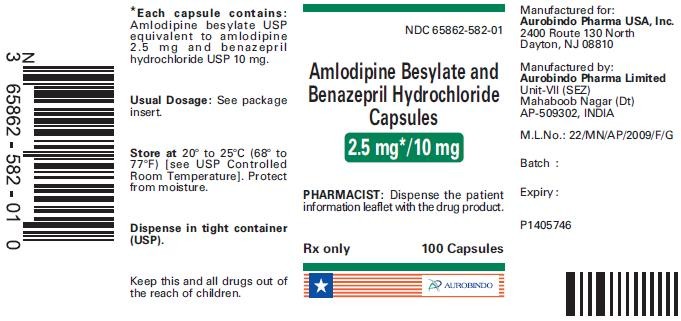
PACKAGE LABEL-PRINCIPAL DISPLAY PANEL - 5 mg/10 mg (100 Capsule Bottle)
NDC 65862-583-01
Amlodipine Besylate and
Benazepril Hydrochloride Capsules
5 mg*/10 mg
PHARMACIST:
Rx only 100 Capsules
AUROBINDO
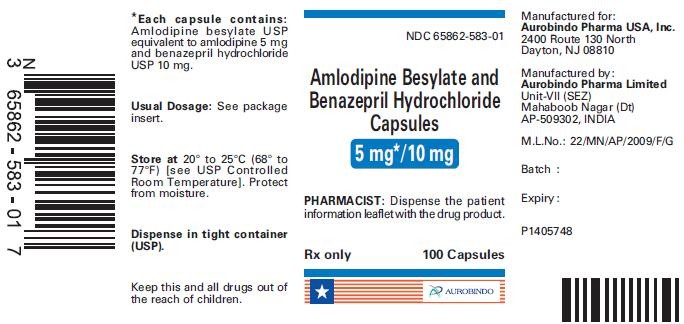
PACKAGE LABEL-PRINCIPAL DISPLAY PANEL - 5 mg/20 mg (100 Capsule Bottle)
NDC 65862-584-01
Amlodipine Besylate and
Benazepril Hydrochloride Capsules
5 mg*/20 mg
PHARMACIST:
Rx only 100 Capsules
AUROBINDO
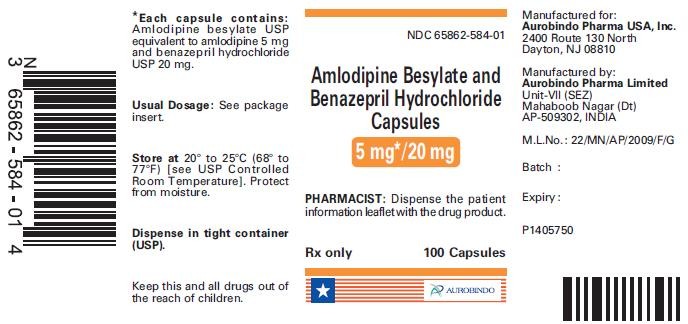
PACKAGE LABEL-PRINCIPAL DISPLAY PANEL - 5 mg/40 mg (100 Capsule Bottle)
NDC 65862-585-01
Amlodipine Besylate and
Benazepril Hydrochloride Capsules
5 mg*/40 mg
PHARMACIST:
Rx only 100 Capsules
AUROBINDO
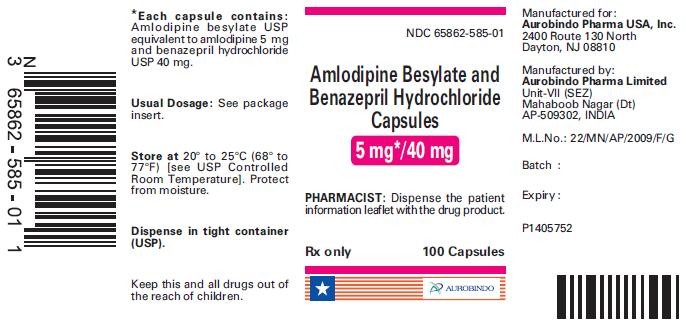
PACKAGE LABEL-PRINCIPAL DISPLAY PANEL - 10 mg/20 mg (100 Capsule Bottle)
NDC 65862-586-01
Amlodipine Besylate and
Benazepril Hydrochloride Capsules
10 mg*/20 mg
PHARMACIST:
Rx only 100 Capsules
AUROBINDO
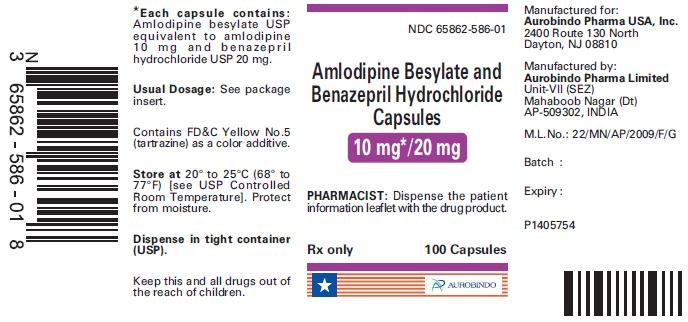
PACKAGE LABEL-PRINCIPAL DISPLAY PANEL - 10 mg/40 mg (100 Capsule Bottle)
NDC 65862-587-01
Amlodipine Besylate and
Benazepril Hydrochloride Capsules
10 mg*/40 mg
PHARMACIST:
Rx only 100 Capsules
AUROBINDO

Amlodipine Besylate and Benazepril HydrochlorideAmlodipine Besylate and Benazepril Hydrochloride CAPSULE
| ||||||||||||||||||||||||||||||||||||||||||||||||||||||||||||||||||||||||||||||||||||||||||||||
Amlodipine Besylate and Benazepril HydrochlorideAmlodipine Besylate and Benazepril Hydrochloride CAPSULE
| ||||||||||||||||||||||||||||||||||||||||||||||||||||||||||||||||||||||||||||||||||||||||||||||||||
Amlodipine Besylate and Benazepril HydrochlorideAmlodipine Besylate and Benazepril Hydrochloride CAPSULE
| ||||||||||||||||||||||||||||||||||||||||||||||||||||||||||||||||||||||||||||||||||||||||||||||||
Amlodipine Besylate and Benazepril HydrochlorideAmlodipine Besylate and Benazepril Hydrochloride CAPSULE
| ||||||||||||||||||||||||||||||||||||||||||||||||||||||||||||||||||||||||||||||||||||||||||||||||||
Amlodipine Besylate and Benazepril HydrochlorideAmlodipine Besylate and Benazepril Hydrochloride CAPSULE
| ||||||||||||||||||||||||||||||||||||||||||||||||||||||||||||||||||||||||||||||||||||||||||||||||||||||
Amlodipine Besylate and Benazepril HydrochlorideAmlodipine Besylate and Benazepril Hydrochloride CAPSULE
| ||||||||||||||||||||||||||||||||||||||||||||||||||||||||||||||||||||||||||||||||||||||||||||||||||